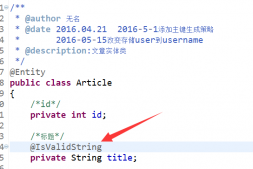在前面的博客中,https://www.zzvips.com/article/153013.html 我们使用了spring boot的异步操作,当时,我们使用的是默认的线程池,但是,如果我们想根据项目来定制自己的线程池了,下面就来说说,如何定制线程池!
一、增加配置属性类
|
1
2
3
4
5
6
7
8
9
10
|
package com.chhliu.springboot.async.configuration; import org.springframework.boot.context.properties.ConfigurationProperties; @ConfigurationProperties(prefix = "spring.task.pool") // 该注解的locations已经被启用,现在只要是在环境中,都会优先加载 public class TaskThreadPoolConfig { private int corePoolSize; private int maxPoolSize; private int keepAliveSeconds; private int queueCapacity; …………省略getter,setter方法………… } |
二、创建线程池
|
1
2
3
4
5
6
7
8
9
10
11
12
13
14
15
16
17
18
19
20
21
22
23
24
25
26
27
28
29
|
package com.chhliu.springboot.async.pool; import java.util.concurrent.Executor; import java.util.concurrent.ThreadPoolExecutor; import org.springframework.beans.factory.annotation.Autowired; import org.springframework.context.annotation.Bean; import org.springframework.context.annotation.Configuration; import org.springframework.scheduling.annotation.EnableAsync; import org.springframework.scheduling.concurrent.ThreadPoolTaskExecutor; import com.chhliu.springboot.async.configuration.TaskThreadPoolConfig; @Configuration@EnableAsyncpublic class TaskExecutePool { @Autowired private TaskThreadPoolConfig config; @Bean public Executor myTaskAsyncPool() { ThreadPoolTaskExecutor executor = new ThreadPoolTaskExecutor(); executor.setCorePoolSize(config.getCorePoolSize()); executor.setMaxPoolSize(config.getMaxPoolSize()); executor.setQueueCapacity(config.getQueueCapacity()); executor.setKeepAliveSeconds(config.getKeepAliveSeconds()); executor.setThreadNamePrefix("MyExecutor-"); // rejection-policy:当pool已经达到max size的时候,如何处理新任务 // CALLER_RUNS:不在新线程中执行任务,而是由调用者所在的线程来执行 executor.setRejectedExecutionHandler(new ThreadPoolExecutor.CallerRunsPolicy()); executor.initialize(); return executor; } } |
三、在主类中开启配置支持
|
1
2
3
4
5
6
7
8
9
10
11
12
13
14
|
package com.chhliu.springboot.async; import org.springframework.boot.SpringApplication; import org.springframework.boot.autoconfigure.SpringBootApplication; import org.springframework.boot.context.properties.EnableConfigurationProperties; import org.springframework.scheduling.annotation.EnableAsync; import com.chhliu.springboot.async.configuration.TaskThreadPoolConfig; @SpringBootApplication@EnableAsync@EnableConfigurationProperties({TaskThreadPoolConfig.class} ) // 开启配置属性支持 public class SpringbootAsyncApplication { public static void main(String[] args) { SpringApplication.run(SpringbootAsyncApplication.class, args); } } |
四、测试类
|
1
2
3
4
5
6
7
8
9
10
11
12
13
|
package com.chhliu.springboot.async.pool; import org.slf4j.Logger; import org.slf4j.LoggerFactory; import org.springframework.scheduling.annotation.Async; import org.springframework.stereotype.Component; @Componentpublic class AsyncTask { protected final Logger logger = LoggerFactory.getLogger(this.getClass()); @Async("myTaskAsyncPool") //myTaskAsynPool即配置线程池的方法名,此处如果不写自定义线程池的方法名,会使用默认的线程池 public void doTask1(int i) throws InterruptedException{ logger.info("Task"+i+" started."); } } |
五、测试
|
1
2
3
4
5
6
7
8
9
10
11
12
13
14
15
16
17
18
19
20
21
22
23
24
|
package com.chhliu.springboot.async; import java.util.concurrent.ExecutionException; import org.junit.Test; import org.junit.runner.RunWith; import org.slf4j.Logger; import org.slf4j.LoggerFactory; import org.springframework.beans.factory.annotation.Autowired; import org.springframework.boot.test.context.SpringBootTest; import org.springframework.test.context.junit4.SpringRunner; import com.chhliu.springboot.async.pool.AsyncTask; @RunWith(SpringRunner.class) @SpringBootTestpublic class SpringbootAsyncApplicationTests { protected final Logger logger = LoggerFactory.getLogger(this.getClass()); @Autowired private AsyncTask asyncTask; @Test public void AsyncTaskTest() throws InterruptedException, ExecutionException { for (int i = 0; i < 100; i++) { asyncTask.doTask1(i); } logger.info("All tasks finished."); } } |
测试结果如下:
2017-03-20 20:15:15.208 INFO 4068 --- [ MyExecutor-10] c.c.springboot.async.pool.AsyncTask : Task60 started.
2017-03-20 20:15:15.208 INFO 4068 --- [ MyExecutor-25] c.c.springboot.async.pool.AsyncTask : Task61 started.
2017-03-20 20:15:15.208 INFO 4068 --- [ MyExecutor-6] c.c.springboot.async.pool.AsyncTask : Task62 started.
2017-03-20 20:15:15.208 INFO 4068 --- [ MyExecutor-23] c.c.springboot.async.pool.AsyncTask : Task63 started.
2017-03-20 20:15:15.208 INFO 4068 --- [ MyExecutor-20] c.c.springboot.async.pool.AsyncTask : Task64 started.
2017-03-20 20:15:15.208 INFO 4068 --- [ MyExecutor-19] c.c.springboot.async.pool.AsyncTask : Task65 started.
2017-03-20 20:15:15.208 INFO 4068 --- [ MyExecutor-16] c.c.springboot.async.pool.AsyncTask : Task66 started.
2017-03-20 20:15:15.208 INFO 4068 --- [ MyExecutor-15] c.c.springboot.async.pool.AsyncTask : Task67 started.
2017-03-20 20:15:15.208 INFO 4068 --- [ MyExecutor-12] c.c.springboot.async.pool.AsyncTask : Task68 started.
2017-03-20 20:15:15.209 INFO 4068 --- [ MyExecutor-1] c.c.springboot.async.pool.AsyncTask : Task69 started.
2017-03-20 20:15:15.209 INFO 4068 --- [ MyExecutor-11] c.c.springboot.async.pool.AsyncTask : Task81 started.
2017-03-20 20:15:15.209 INFO 4068 --- [ MyExecutor-8] c.c.springboot.async.pool.AsyncTask : Task82 started.
2017-03-20 20:15:15.209 INFO 4068 --- [ MyExecutor-7] c.c.springboot.async.pool.AsyncTask : Task83 started.
2017-03-20 20:15:15.209 INFO 4068 --- [ MyExecutor-4] c.c.springboot.async.pool.AsyncTask : Task84 started.
2017-03-20 20:15:15.209 INFO 4068 --- [ MyExecutor-29] c.c.springboot.async.pool.AsyncTask : Task85 started.
2017-03-20 20:15:15.209 INFO 4068 --- [ MyExecutor-21] c.c.springboot.async.pool.AsyncTask : Task86 started.
2017-03-20 20:15:15.209 INFO 4068 --- [ MyExecutor-17] c.c.springboot.async.pool.AsyncTask : Task88 started.
测试结果ok!
六、配置默认的线程池
如果我们想使用默认的线程池,但是只是想修改默认线程池的配置,那怎么做了,此时我们需要实现AsyncConfigurer类,示例代码如下:
|
1
2
3
4
5
6
7
8
9
10
11
12
13
14
15
16
17
18
19
20
21
22
23
24
25
26
27
28
29
30
31
32
33
34
35
36
37
38
39
40
41
42
43
44
45
46
47
|
import java.lang.reflect.Method; import java.util.concurrent.Executor; import java.util.concurrent.ThreadPoolExecutor; import org.springframework.aop.interceptor.AsyncUncaughtExceptionHandler; import org.springframework.beans.factory.annotation.Autowired; import org.springframework.context.annotation.Configuration; import org.springframework.scheduling.annotation.AsyncConfigurer; import org.springframework.scheduling.concurrent.ThreadPoolTaskExecutor; import com.chhliu.cq.emailservice.threadconfiguration.TaskThreadPoolConfig; import lombok.extern.slf4j.Slf4j; /** * 注意:该线程池被所有的异步任务共享,而不属于某一个异步任务 * 描述:配置异步任务的线程池 * @author chhliu * 创建时间:2017年5月22日 上午10:20:56 * @version 1.2.0 */@Slf4j@Configurationpublic class AsyncTaskExecutePool implements AsyncConfigurer{ @Autowired private TaskThreadPoolConfig config; // 配置属性类,见上面的代码 @Override public Executor getAsyncExecutor() { ThreadPoolTaskExecutor executor = new ThreadPoolTaskExecutor(); executor.setCorePoolSize(config.getCorePoolSize()); executor.setMaxPoolSize(config.getMaxPoolSize()); executor.setQueueCapacity(config.getQueueCapacity()); executor.setKeepAliveSeconds(config.getKeepAliveSeconds()); executor.setThreadNamePrefix("taskExecutor-"); // rejection-policy:当pool已经达到max size的时候,如何处理新任务 // CALLER_RUNS:不在新线程中执行任务,而是由调用者所在的线程来执行 executor.setRejectedExecutionHandler(new ThreadPoolExecutor.CallerRunsPolicy()); executor.initialize(); return executor; } @Override public AsyncUncaughtExceptionHandler getAsyncUncaughtExceptionHandler() {// 异步任务中异常处理 return new AsyncUncaughtExceptionHandler() { @Override public void handleUncaughtException(Throwable arg0, Method arg1, Object... arg2) { log.error("=========================="+arg0.getMessage()+"=======================", arg0); log.error("exception method:"+arg1.getName()); } }; } } |
使用的时候,只需在方法上加上@Async即可。
总结
以上所述是小编给大家介绍的spring boot使用自定义的线程池执行Async任务,希望对大家有所帮助,如果大家有任何疑问请给我留言,小编会及时回复大家的。在此也非常感谢大家对服务器之家网站的支持!
原文链接:http://blog.csdn.net/liuchuanhong1/article/details/64132520

















